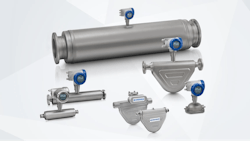The combination of high accuracy, versatility, direct mass measurement and minimal maintenance requirements make Coriolis meters suitable for various industrial applications.
Unlike volumetric flow meters, Coriolis meters directly measure mass flow, making them less susceptible to variations in temperature, pressure and fluid density.
To learn more, Chemical Processing spoke with Alec O’Keefe, regional product lead and Coriolis meter product specialist at KROHNE Inc. KROHNE is based in Beverly, Massachusetts, and has manufacturing, distribution, sales, support and engineering resources that serve multiple markets.
Q: Are all Coriolis meters alike?
A: There are many different flavors of Coriolis meters from a variety of manufacturers, and that variety means there’s one out there for just about every application.
Q: What benefits do Coriolis meters offer, and why does it matter?
A: Coriolis meters are also known as mass meters — and that is a huge benefit. Most flow meters measure flow velocity, and there are a few different ways that they do that. To get to mass, you can make assumptions and do calculations that are generally very good. Now, I don't mean to imply that volumetric flow meters aren't as good or don't have their place; they most certainly do. But when you're dealing with things like chemical reactions that are typically mass-based, if you can cut out some of those calculations and assumptions because your primary measurement is mass flow, that helps. Mass is conserved, volume is not.
Changes in temperature and pressure may introduce unexpected errors. While the main benefit of Coriolis meters is that they directly measure mass flow, that's not all they measure. They are multivariable meters, so you get a live mass flow as well as an independent inline-density measurement, which is not easy. You also get temperature measured directly from the meter. So, with one installation point, you get various useful and accurate measurements.
I would refer to those as front-end measurements. But Coriolis meters also offer back-end measurements like tube frequency, drive level or drive gain, and sensory amplitudes.
Q: How do Coriolis meters handle different fluids like corrosive and multiphase?
A: They can handle just about everything. If you've got something that's close to water, well, that's easy. But once you start getting into very corrosive, aggressive fluids, you must be careful with your wetted parts. It falls upon us collectively, as both the users and the manufacturers, to take this into account.
Coriolis meter tubes are relatively thin, so we must be very careful with corrosion rates in some of these more aggressive chemical applications. That takes the driver's seat when you're selecting a Coriolis meter.
Then we look at things like high-viscosity fluids or something that may be non-Newtonian; those are always a bit of a curve ball. That'll really steer you in terms of the meter size, tube design and tube geometries that you opt to use. Sizing Coriolis meters is a balancing act. As the user of a Coriolis meter, you need to ask yourself, “What's my priority?” If you need the performance to be super precise, you may want to use a smaller meter so you're flowing a little bit faster through it.
Sometimes, you may end up having to sacrifice something. You can't always have your cake and eat it too. You may be willing to sacrifice a bit of performance to make sure that you don't have a pressure loss or vice versa.
Q: What about installation requirements for Coriolis meters?
A: That's a very good question because sometimes you only have so much space. First, you want to support the weight of the meter (Coriolis can go up to 16 inches). Secondly, you want to keep it full for best performance. And finally, you want to avoid cavitation.
One of the great things about Coriolis meters is that since they aren't measuring velocity (they can calculate the flow velocity, but it's not a direct measurement), they don't require any upstream or downstream straight runs. In terms of installing them in short distances of pipe, they're fantastic for that because you're not restricted. They do not care and their performance is not affected by 90-degree bends, valves, and all sorts of other stuff as long as they're not creating cavitation within the meter.
And in terms of mounting orientation, if you're dealing with a liquid, vertical flow up, nobody's ever going to be upset about that. If you're installing a bent tube meter horizontally, you want the belly of that meter to be down below the pipe. Now, if you're using them for gas applications, you'd want the opposite. You'd want that belly upwards. The reason for that is if we have a liquid application and there's any gas, we want that gas to propagate out of the meter. The opposite is true for gas applications. If you have any liquids that may find their way into the meter, we want those to propagate out from the meter so they don't pool up and ultimately impact measurement integrity and cause some issues.
Q: What about maintenance?
A: One of the great things about Coriolis meters is they have no moving parts. There are no bearings, there's no spinning blades or rotating components that may be subject to mechanical wear. However, you need to be conscious of some things when sizing and selecting a meter because some things will cause long-term drift in the performance of a Coriolis meter. To clarify, if you're dealing with something that you know builds up, or on the contrary, if you have anything such as corrosion or erosion that's taking mass away from the tubes, we try to mitigate those possibilities when we're sizing and selecting a Coriolis meter. There's quite a bit that the meter can tell you if you're dealing with applications with buildup. It can diagnose and notify when you need to start to flush. This helps to optimize the cleaning regimen that you may have in place for your other components and applications where there's buildup. So that's quite useful, but I don't think everybody takes advantage of it.
But another low-hanging fruit method of ensuring continued accuracy is meter verification via software, hardware or a button on the display. Essentially, you can ask the meter, “Are you still operating correctly?” It checks its own internal values, compares those against its factory values and prints out a report that says, yes, I am. Conversely, if there is an issue, it will give you proposed corrective actions.
Troubleshooting 101 is trying the easiest thing first. So, if you have a super easy way of checking the meter's integrity, start with that. However, verification isn't calibration. As manufacturers, we have some wildly advanced traceable and highly accurate calibration facilities and calibration rigs that we are using for calibrating these incredibly accurate meters. So, if you want to truly ensure meter performance where the rubber hits the road in process plant operations, a meter should be periodically calibrated against something that's at least three times more accurate than it is.
Q: Coriolis meters are expensive. What are some of the limitations or disadvantages, and are there conditions where they may not be suitable for a particular application?
A: Coriolis meters may introduce a larger pressure loss than many other flow technologies. So, if you're introducing a pressure loss, you can get flashing, and that's no good.
Another range of applications that don't always make the most sense to use a Coriolis meter is if you're dealing with a low-pressure gas. Because these meters measure mass flow, low-pressure gases with their low densities don’t generate a lot of mass flow. A gas that is especially tricky because it is so light is hydrogen.
As meters get larger, they don't require any inlet or outlet straight runs, but their overall footprint or installation envelope can get quite large. If you're trying to retrofit something, or you're in tight spaces such as a fabricated skid, you may not have the physical space to accommodate the belly that many, but not all Coriolis meters have.
Q: What does KROHNE have that sets its technologies and meters apart?
A: KROHNE was the first manufacturer to figure out how to make a straight tube meter. A straight tube design is a fantastic option if you're dealing with something very viscous. As mentioned earlier, it is also a space saver.
We have various straight tube options: single straight tubes and multi-straight tubes. We can make them from a quarter of an inch up to 16 inches, the highest capacity Coriolis meter on the market today.
We also have a solution that we call Entrained Gas Management. We've had it for about a decade now, and it's a standard feature on all of our meters. It allows the meter to continue to measure with live, repeatable measurements through even the most severe multiphase situations. The diagnostics will tell you that a two-phase flow condition is present while continuing to measure mass flow and density. It'll tell you that the integrity of your measurement is affected, and it's always running in the background.
Last but not least, our transmitter has Bluetooth functionality, which is a massive improvement in the user interface. Instead of pushing buttons or dealing with handhelds, modems, and computer software, you now have a service tool in a phone app. Users can securely connect to a flow meter to configure it, commission it, or perform a meter verification from a phone or tablet that an instrument shop may already use elsewhere.
For more information, visit: https://us.krohne.com/


